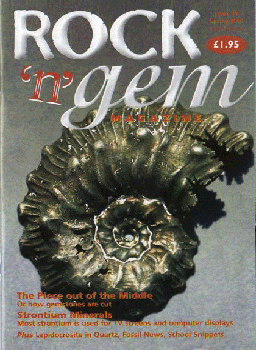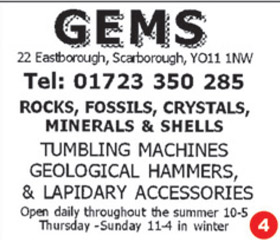
Rock n Gem Magazine Issue 39
Published Spring 2007
Healing Gemstones, Coloured Gemstone Report, Diamond Grading Course,
Fossil News, Lepidocrosite in Quartz, Rockwatch Guide No 1, Piece out of the Middle,
Rock 'n' Gem Shows, Strontium Minerals, Web Directory, Tubes of Escape,
School Snippets, Contemporary Jet, The Value of Nephrite, The Beauty of Opal
Cosmic Diamond, The Mysterious Beauty of Amber, Gemmology BTEC,
Shops Page, Subscribe, Shows and Classifieds.
Mysterious beauty of amber
Being a first year gemmology student I am interested in all the wonderful gems and minerals and amber is among my favourites. Easily accessible in Poland, my country of origin, it was probably the first gem that made me curious enough to start asking questions about it…
Very early in my childhood I was playing with pine’s resin imagining it would soon turn to amber and the biggest attraction during holidays by the Baltic Sea was going to the beach after the storm and collecting small pieces of this gem. My child’s imagination was also stimulated with the story of the mysteriously lost Amber Room. It was not long ago that my knowledge about this organic material shaped up in a more scientific rather than romantic way.
The formation of amber is dependent on the production of tree resin under the conditions enabling the preservation of the hardened resin. There are around 20 rich deposits of amber in the world, among which the two major ones are Dominican Republic and Baltic Sea.
The resin can be produced by various conifer and some tropical trees.The production of it is probably a defence mechanism that trees developed against insects and disease. Moreover when the tree is injured, a resin acts in a similar way to a scab on the human body, as it is excreted, covering the wound and then it hardens. Thanks to this property amber could preserve some incredible inclusions such as spiders, little insects or even a lizard. Inclusions of that type are relatively rare and therefore they are sought after.
Amber can be used in jewellery as well as in the production of decorative objects such as sculptures, chess sets, candleholders to name a few. In the Baroque period the carving of this material was very popular, which resulted in many incredible works of art, among which The Amber Room is probably the most splendid one. The creation of the room was requested by the King of Prussia, Frederic I and it was first carried out by Gottfried Wolffram and Eosander von Göthe. However after the disagreement between the two artists the work moved to the then German city of Gdaƒsk. In 1713 The Amber Room was presented in its full glory in the royal palace at Berlin, and later it was offered as a gift to the Russian Tsar, Peter the Great.The room was put up in the Summer Palace and in 1763 the last finishing touches were carried out. The Amber Room was described as ‘one of the Wonders of the World’1, but unfortunately it cannot be admired today. In 1941 the Germans marched into Leningrad and it is believed that The Amber Room was then transported to the Prussian Fine Art Museum under Alfred Rohde’s discretion. It was moved again after that and that is when all trace of The Amber Room disappeared. Since then there were many speculations regarding the place where it could be hidden, but the mystery remains unsolved. We may not ever know the true story behind The Amber Room as there are no signs of it. What we are left with today is the reconstruction works of The Amber Room based on eighty six photographs and many descriptions, and a hope that the universal beauty of this semiprecious gem will give justice to the lost Baroque work of Art.
Lepidocrosite in Quartz
hope this article will help clear up some of the confusion surrounding the very fine, needle like inclusions in Quartz. Lepidocrosite is undoubtedly a wonderful creation of nature that is often confused with Rutile.
I am convinced the sight of this beautiful mineral and its associations will leave you awestruck.Take a close look at the long strands that are found in clear quartz in what is often referred to as Super Seven Quartz. These crystals often appear to almost glow with both fiery red and glistening black crystal strands, often rival the other well known beauty of fine gold or silver Rutile needles seemingly suspended in an often water clear quartz. Lepidocrosite, as mentioned above can be red, purple or brown shading into black; this is both the charm and also a clue to the origins. As you have probably guessed, Lepidocrosite is in fact a colourful variety of Goethite as a hydrated iron oxide, (see the illustration of Lepidocrosite on Goethite from Spain). Other named varieties are Akaganite and Feroxyhyate, If you are feeling confused, we will ignore the other two rare varieties as they require very specialised equipment for investigation!.
Lepidocrosite often occurs together with bright black plates of Haematite, sometimes in the presence of purple Amethyst, what a combination! In a very different sample from Siberia, you can see thin brown and red mica like plates of Goethite, together with shiny black Haematite, both examples exhibit a similar platy structure of Lepidocrosite, here shading from red to black. Technically this mineral group is known as hydrated Iron oxide, a polymorph of Goethite, having the same overall chemistry but a different crystal form. When strands of Lepidocrosite are found, seemingly floating inside clear Quartz, they frequently outline a quartz crystal phantom. When existing as fine strands these are often elongated sometimes twisted strings, easily recognised, especially when found in water clear quartz. The golden tufts often found in Amethyst are actually yet another variety of Goethite and not the golden sprays of Cacoxenite. The mineral Cacoxenite, is known as a different type of mineral, in fact it is classed as a phosphate mineral; as such it is said to never be found inside Quartz. There seems to be plenty of room for confusion here, not least because Cacoxenite is also listed as one of the seven minerals in Super Seven Quartz. Out of interest, Quartz has another accomplice that is called Moganite, only recently found (1970’s), this is yet another Silicon dioxide mineral, but has a different crystal form to quartz;
it is very difficult to distinguish Moganite from the usual Quartz and Chalcedony. Apparently this mineral occurs in microscopic twisted strands, as Lepidocrosite is also found in more visible twisted strands, is their a possible link? Moganite apparently comprises approximately 10% of any Quartz or Chalcedony, usually found in Agates. The varieties of Quartz with Lepidocrosite crystals inside that are frequently mentioned are listed here.
Harlequin Quartz
Harlequin quartz from Madagascar, displays its beauty in the random inclusion of the Iron rich minerals as bright red flakes and slender strings such as Lepidocrosite, found together with lustrous black Haematite. When the beauty of Lepidocrosite became better known, it has also been reported as appearing in several other locations, including Namibia (Brandberg), Siberia and Brazil.
Fire Quartz
Fire quartz is the name used for the variety of quartz that contains this magical mineral, usually as bright red platy mica like inclusions, as opposed to the String like form. Fire quartz is also often confused with rutile quartz that is coloured by fine needles of red Rutile. There is also a Mexican fire agate that is occasionally called Fire Quartz (a Chalcedony).
Raspberry Quartz
Another colloquial name; this has fallen out of favour due to a manufactured material being given this name in order to increase its commercial value. Cherry Quartz or more recently Galaxy Quartz is the name that should be applied to this decorative material; it is not Quartz and looks man made and as such it often feels warm to the touch.
Strawberry Quartz
Yet another colloquially named variety of quartz, this has thin flakes of bright red Lepidocrosite and is often found in cut and polished quartz cabochons from Brazil. This particular quartz is sometimes accompanied by an unidentified green flaky material in examples from Brazil, another diagnostic and visually stunning combination.
Super Seven Quartz
The large variety of Inclusions found in some Quartz crystals from Espiritos-du-Santos, Minas Gerais, Brazil, are sold by crystal healing fans as either Super Seven Quartz or Melody Stone. Here the Lepidocrosite crystals appear as long thin strands, amongst a combination of Amethyst, Smoky and Clear Quartz. This variety of quartz is said to contain the metaphysical power of all three subtypes of quartz, Amethyst, Smoky and Clear, even when none can be seen? In addition these crystals are said to act as a host for Lepidocrosite, Rutile (unconfirmed), Haematite and strangely Cacoxenite, (probably a bright yellow variety of Goethite)? A similar combination of mineral types has been found in Agate slices.
Brandberg Quartz
Strange Lepidocrosite flakes and strings also occur in the often-patchy variety of Amethyst to be found in material from the Brandberg Mountains, Namibia. These are found here together with fluid inclusions and wispy veils, as well as Amethyst, smoky and clear quartz.









